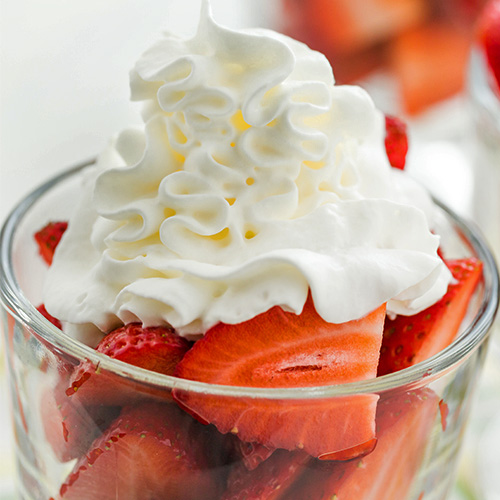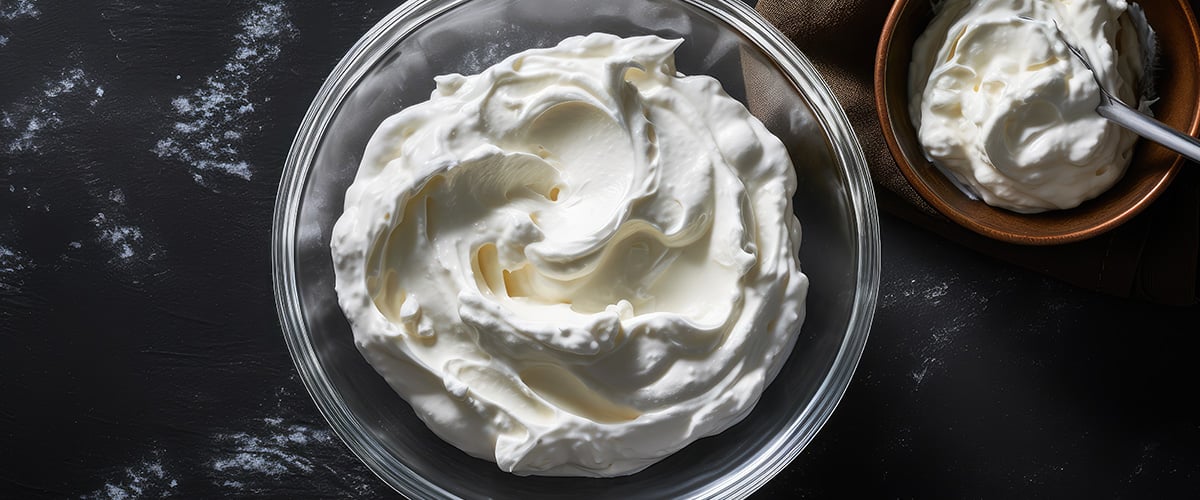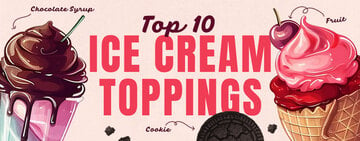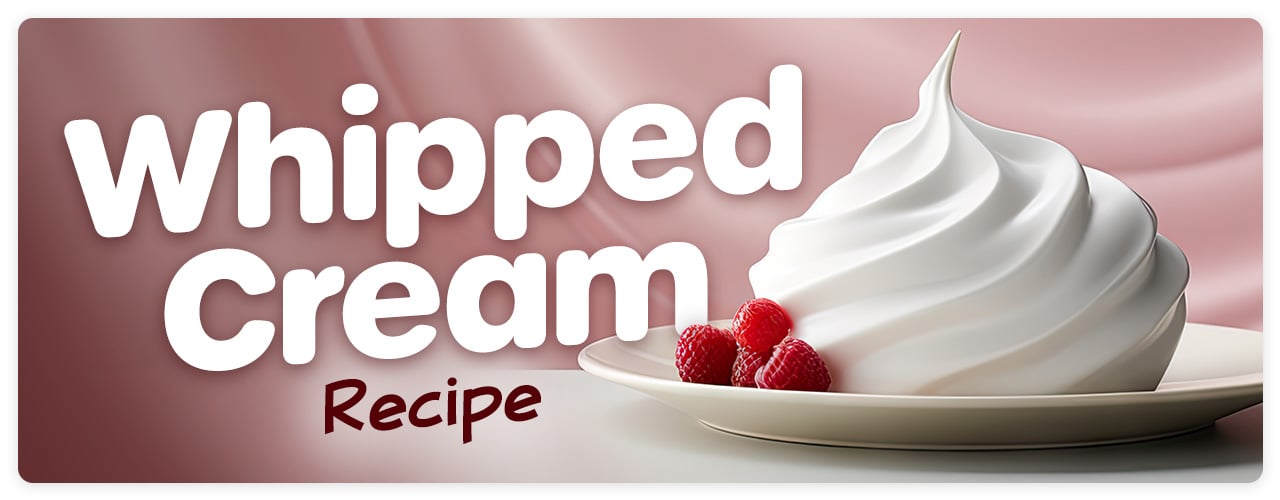Buying pre-made whipped cream is quick and convenient, but there are numerous benefits to making your own whipped cream in-house. Homemade whipped cream gives you complete control over the ingredients and can save you money in the long run. The cost per serving of homemade whipped cream is significantly lower compared to pre-packaged options. This can result in substantial savings, especially for establishments that frequently use whipped cream in their menu offerings. Try our simple recipe and the results just might convince you!
Whipped Cream from Scratch
Watch our video to learn how to make your own whipped cream with just a few simple ingredients.
What Special Equipment Do I Need?
To get started with this fresh whipped cream recipe, you'll only need two kitchen items:
- Electric stand mixer or electric whisk attachment - We use the AvaMix immersion blender with a whisk attachment, but you can also use a stand mixer or handheld mixer.
- Large mixing bowl - You'll need a large bowl with enough room to move the whisk around. The heavy cream will also increase in size as it becomes whipped full of air, so the bowl should be big enough to accommodate the final product. We recommend a bowl with a wide diameter like the Choice 20-quart stainless steel mixing bowl.
Whipped Cream Recipe

Approximate Yield: 4 cups whipped cream
Time: 5 minutes
Ingredients
- 2 cups heavy cream
- 2 tablespoons confectioner’s sugar, sifted
- 2 teaspoons vanilla extract
Directions
- Add heavy cream to large mixing bowl and chill for at least an hour
- Remove container from refrigeration and add confectioner’s sugar and vanilla extract to heavy cream
- Using an electric whisk attachment, blend heavy cream at medium speed
- Continue blending until the cream starts to form stiff peaks
- Best served immediately, but can be stored in refrigeration for 1 day
Whipped Cream FAQ
If you're new to the world of homemade whipped cream, you may have a few questions. Here are some frequently asked questions about making homemade whipped cream:
What Are Stiff Peaks?
The term "stiff peaks" is used frequently in recipes, but what exactly does it mean? This common phrase means the whipped cream holds its shape firmly when the beaters or whisk are lifted. At this stage, the cream has been whipped enough to form peaks that stand upright without collapsing. Test out the whipped cream by pulling the whisk up and out of the mixture. If you see peaks form, then you have reached the right stage!
What Type of Heavy Cream Should I Use?
For the best results with homemade whipped cream, we recommend using fresh heavy cream with a fat content of at least 36%. Look for products labeled "heavy cream" or "heavy whipping cream". You can use a lighter product with less fat, but keep in mind that the results will not be as thick or stable.
Can I Whisk Whipped Cream by Hand?
Yes, you can use a hand whisk to make whipped cream if you are only making a small amount. Your arm would get very tired from whisking several cups and the results might not be consistent.
Can I Make Vegan Whipped Cream?
Yes, it's possible to make vegan whipped cream that contains no dairy. You'll need a can of full-fat coconut milk (not the carton variety). Simply refrigerate the can overnight, scoop out the solidified coconut cream, and whip it until it reaches a light and fluffy consistency. You can also add a sweetener like powdered sugar or maple syrup to enhance the flavor.

In just a matter of minutes, you can have freshly made whipped cream to use on your desserts and beverages. Making your own whipped topping gives you complete control over the ingredients used, and you'll also save money in the process. You can even use this whipped cream recipe as a base and experiment with adding different flavoring syrups and sauces, or even swapping the vanilla extract for another flavor extract to complement your signature menu items. With its ease of preparation, there's no reason not to elevate your menu with homemade whipped cream.
Related Resources

Using a Whipped Cream Dispenser
Whipped cream siphons are versatile pieces of equipment that are most commonly used for creating fresh whipped cream. But, these siphons have a variety of uses in foodservice that many chefs may not know about. Keep reading to learn about what whipped cream dispensers are, how they work, and three unique ways that you can use them in your bar or restaurant. Shop Whipped Cream Dispensers and Chargers What Is a Whipped Cream Dispenser? A whipped cream dispenser is a handheld kitchen tool that uses nitrous oxide gas to whip ingredients, which gives them a soft and pillowy texture. Whipped cream siphons work by incorporating nitrous oxide gas into the product, which then creates lots of tiny bubbles and gives it a light and whipped texture. What Are Whipped Cream Chargers? Whipped cream chargers are small metal canisters that are filled with nitrous oxide (N2O) and placed into a whipped cream dispenser's charger holder. When activated, the N2O is released into the canister and stabilizes the cream, making it thick and airy. How to Use a Whipped Cream Dispenser Making your own whipped cream is super easy, requires minimal ingredients, and is ready to use in no time. Plus, it can help save on costs and it does not contain any gums, additives, or emulsifiers, unlike most store-bought whipped creams. Insert head gasket into dispenser head. Insert dispensing piston into dispenser head. Screw decorator tip onto dispensing piston. Fill bottle with pre-chilled mixture. Be sure not to overfill past fill line. Screw dispenser head onto bottle, making sure it is secured tightly and evenly. Insert compatible whipped cream charger into the charger holder. Screw the charger holder with the inserted charger onto dispenser head until hearing hissing sound of gas being released. Vigorously shake bottle six to ten times. Unscrew charger holder and throw out empty charger, recycling it if possible. Turn the whipper upside down and gently press lever to dispense. Three Unique Ways to Use Your Whipper While many foodservice professionals refer to the tool as a whipped cream dispenser or siphon, it can be used for many tasks other than making whipped cream. Many dispensers also come with several different tips and accessories, which you can use to decorate baked goods or to create a beautiful presentation for your customers. Here are three foods that you can make using a whipper: 1. Espumas You may have never heard the word ‘espuma,’ but if you’ve eaten at a gastropub or fine-dining establishment, chances are you’ve eaten espuma before. Espuma is a Spanish word that means foam or froth, and, in cooking, it refers to warm edible foam. Espumas are made by combining vegetable purees, soup, or stock with a thickening agent and nitrous oxide, creating an airy, edible foam. When plating your dishes and espumas, you can use different attachments to create an attractive presentation. 2. Batters Another unique use for your whipper is creating bubbly and airy batters for pancakes, waffles, or deep frying. Occasionally, pancake and waffle batter can end up thick, resulting in a product that is too dense. One way to ensure that your batter turns out light is to use a whipper. Adding nitrous oxide to your batter creates light and pillowy pancakes and waffles. Additionally, you can use whipped cream chargers to lighten your fry batter, resulting in crisp fried food that isn't too heavy or oily. 3. Cocktails Although cream whippers are mainly used in kitchens for food preparation, you can use them to make a variety of cocktails and beverages. Additionally, you can make multiple kinds of cocktails in whippers, ranging from drinks that are fizzy and bubbly to others that are thick and creamy. Even if you're looking to make non-alcoholic drinks, injecting your cocktails with nitrous oxide can give them an effervescent texture and refreshing taste. Cream dispensers and whippers have a variety of uses outside of just making fresh whipped cream. You can use them to create airy foams, delicate batters, and even bubbly cocktails. Plus, there are several types of attachments and accessories that you can outfit your whipped cream dispenser with, increasing their capabilities. As a result, whippers and dispensers are the perfect multi-purpose tool for any style of foodservice establishment.

Differences between Creme Fraiche, Sour Cream, Mascarpone, and Cream Cheese
Creme fraiche, sour cream, mascarpone, and cream cheese add a rich, velvety consistency and flavor to your culinary creations. These versatile ingredients can be used to cool down spicy dishes, for cooking, or in baking applications. While these creamy ingredients may appear similar at first glance, each one brings a unique taste and texture to the table. Understanding the differences between them will help you choose the right option for your recipe. When done properly, you can substitute them for each other without altering the flavor and consistency of your recipe. Skip to the ingredient that interests you: 1. Creme Fraiche 2. Sour Cream 3. Mascarpone 4. Cream Cheese What Is Creme Fraiche? Creme fraiche is a French-style cultured cream with a rich and velvety texture and a slightly tangy and nutty flavor profile. It's made by combining heavy cream with a culture of bacteria. Its fat content is typically around 30-40%, giving it a luxurious mouthfeel and creamy consistency. Its high-fat content also allows chefs to whip it into soft peaks, making it a popular choice for desserts and pastry fillings. Creme fraiche is used in both cooking and baking. It can be added to pasta sauces, soups, and dressings to provide a rich and creamy base, or used as a topping for fresh fruit, desserts, or even savory dishes like baked potatoes or tacos. Its tangy flavor can help balance the sweetness of desserts or add a depth of flavor to savory dishes. Creme fraiche must be refrigerated at all times to maintain its freshness and prevent spoilage. It has a relatively short shelf life compared to other dairy products, so use it within a week or two of opening. What Is the Difference between Creme Fraiche and Sour Cream? Sour cream is cream that has been fermented with a culture of lactic acid bacteria. Creme fraiche is traditionally made from unpasteurized cream, where fermentation bacteria are naturally present. If pasteurization laws forbid this (such as in the United States), creme fraiche is produced with a starter culture of bacteria instead. Sour cream may contain thickening agents like gelatin or polysaccharides to create a smooth texture, while creme fraiche's fermentation process naturally produces a thicker texture than sour cream. Plus, sour cream has a tangier taste than creme fraiche, which has a rich and creamy taste. This is in part because creme fraiche contains more fat than sour cream, with 30% compared to sour cream's 20% fat content. Creme Fraiche vs. Cream Cheese Creme fraiche is a French-style cultured cream that is thick, rich, and slightly tangy with a velvety texture. It's commonly used in sauces, soups, and dressings because you can heat it without curdling it. Cream cheese is a soft, spreadable cheese that is made from a mixture of cream and milk. It has a mild, slightly tangy flavor and a smooth, creamy texture. It’s a versatile ingredient that is often used in both sweet and savory dishes, such as cheesecakes, dips, frostings, and spreading atop different types of bagels. What Is Sour Cream? Sour cream is made from pasteurized cream fermented with lactic acid bacteria. It has a smooth and creamy texture with a slightly thick consistency. Its tangy, slightly acidic flavor profile adds depth and complexity to dishes. The level of tanginess can vary depending on the brand and production process, making it important to taste and adjust seasoning when using sour cream in recipes. Sour cream is a versatile ingredient that can be used in a variety of culinary applications. It is commonly used as a topping for baked potatoes, nachos, and walking tacos, adding a creamy and tangy element to these dishes. Sour cream is also used in baking to add moisture and richness to cakes, muffins, and quick breads. It should be stored in the refrigerator at all times to maintain its freshness and quality. Can I Use Sour Cream as a Creme Fraiche Substitute? Yes, you can use sour cream as a substitute for creme fraiche. Substitute 1 cup of creme fraiche with 1 cup of sour cream, but reduce the heat to a simmer or lower because sour cream curdles at high temperatures. Sour Cream vs. Cream Cheese While sour cream is made by fermenting cream, cream cheese is made by curdling milk, draining it, and processing it into a smooth, soft cheese. As a result, cream cheese does not have the same sour taste that sour cream has. Cream cheese also contains more fat than sour cream: a minimum of 33% milk fat is required for cream cheese, whereas sour cream contains 20% fat. What Is Mascarpone? Mascarpone is a rich and creamy Italian cheese that is a popular ingredient in both sweet and savory dishes. Made from cream that was coagulated with tartaric or citric acid, mascarpone has a high-fat content, typically around 60-75%. This gives mascarpone its smooth and luscious consistency. Unlike some other soft cheeses, mascarpone is unaged, so it has a delicate flavor and is best consumed fresh. Mascarpone is a luxurious addition to desserts like tiramisu, cheesecakes, and frostings. It's also used in savory dishes to add richness and creaminess. It can be mixed with herbs and seasonings to create a flavorful spread for crackers or used as a topping for grilled meats and vegetables. It should be stored in the refrigerator and used within a few days of opening to ensure the best flavor and texture. Mascarpone vs. Creme Fraiche Mascarpone is a rich and creamy Italian cheese made from cow's milk. It has a mild and slightly sweet flavor, making it a popular ingredient in both sweet and savory dishes. Creme fraiche is a French cultured cream that has a tangy and slightly nutty flavor. Mascarpone has a high-fat content, typically around 60-75%, giving it a smooth and velvety texture. It is made by adding bacterial cultures to heavy cream and allowing it to ferment, resulting in a thick and creamy product. Creme fraiche has a lower fat content compared to mascarpone, typically around 30-40%, and is known for its velvety texture and rich taste. Mascarpone and creme fraiche can be used interchangeably in some recipes, but their distinct flavors and textures make them better suited for specific applications. Mascarpone is ideal for adding richness and creaminess to desserts and sauces, while creme fraiche is perfect for adding a tangy and slightly acidic kick to dishes. What Is Cream Cheese? Cream cheese is made from a combination of cream, milk, and sometimes salt. It has a high-fat content, which gives it a rich and creamy texture. Cream cheese also has a high moisture content, which gives it its spreadable consistency. It's commonly used as a topping for bagels, toast, and baked goods. Cream cheese adds richness and creaminess to dishes such as sauces, soups, and casseroles. It can also be mixed with herbs, spices, or sweet ingredients to create dips, spreads, cheesecakes, and different types of frostings. Cream cheese should be kept refrigerated. Store cream cheese in an airtight container away from foods with strong odors, as it can easily pick up these flavors. Unopened cream cheese can typically last in the refrigerator for about two to three weeks past the sell-by date. Once opened, cream cheese should be consumed within one to two weeks for optimal freshness. Mascarpone vs. Cream Cheese Mascarpone is categorized as a cream cheese, but it is different than what we know as “cream cheese” in America. Mascarpone is made similarly to American cream cheese, but it uses a base of whole cream rather than milk. Like cream cheese, it is a fresh cheese that is not aged before it is eaten. Cream cheese contains at least 33% milk fat, and mascarpone may contain 60-75% milk fat. Mascarpone has a buttery flavor that makes it particularly suitable for desserts. It adds richness and a creamy texture, while cream cheese brings a creamy consistency and slightly tangy taste to dishes. For this reason, cream cheese is perfect for both sweet and savory foods. Can I Use Cream Cheese as a Mascarpone Substitute? Yes, cream cheese makes a great substitute for mascarpone. There are two methods to substitute mascarpone: Substitute 1 cup of mascarpone with 1 cup of a cream cheese and whipping cream mixture. To make this mixture, use 1/4 cup of cream for every 8 oz. of cream cheese. Substitute 1 cup of mascarpone with 1 cup of a sour cream and cream cheese mixture. To make this mixture, use 1/2 cup of sour cream and 1/2 cup of cream cheese. Back to Top While creme fraiche, sour cream, cream cheese, and mascarpone may look similar, their unique textures and preparation methods offer distinct benefits and drawbacks when added to your dishes. Learning the nuances between them will allow you to select the proper ingredient to impart a luxurious texture and a rich, creamy flavor to your culinary creations.

Ice Cream Topping Ideas
Increase your profits by upselling ice cream toppings that enhance and contrast with the creamy, cool base flavor. Whether you operate a frozen yogurt shop and are assembling your toppings station or are looking for ice cream sundae ideas, we've rounded up the most popular ice cream toppings so you can start building a solid foundation. Turn a profit at your new ice cream shop by stocking up on these time-tested toppings. Shop All Ice Cream Toppings Learn about the most popular ice cream toppings: 1. Sprinkles 2. Chocolate Syrup/Fudge 3. Whipped Cream 4. Caramel Sauce 5. Candy 6. Strawberry Syrup 7. Maraschino Cherries 8. Crushed Cookies 9. Fruit 10. Peanut Butter Sauce 1. Sprinkles Bright, cheerful, and reminiscent of your childhood birthday cake, sprinkles transform a scoop of ice cream into a party. Not only are they visually appealing, but they also add toothsome texture to the ice cream and increase its sweetness. Sprinkles come in a variety of colors, from white to black and everything in between. While the tiny rod-shaped jimmies are the most well-known shape, sprinkles come in other forms, including sequins, nonpareils, confetti, pearls, sanding sugar, and seasonally shaped sprinkles like hearts and Christmas trees. Sprinkles traditionally have a neutral, sweet flavor. However, chocolate- and vanilla-flavored sprinkles are also popular. Some specialty sprinkles brands offer unique flavors like mint chocolate. Thanks to their neutral flavors, sprinkles can pair well with any ice cream flavor. However, using them as a topping for light-colored frozen treats creates greater visual contrast and helps their colors shine. Vanilla, strawberry, and birthday cake are all well-suited for sprinkle toppings. Sprinkles Tasting Notes: Most are sweet and neutral, chocolate and vanilla flavors are also popular Sprinkles Texture: Firm and hard but yield easily when bitten into Ice Cream Flavors that Complement Sprinkles: Any ice cream flavor, but light-colored ice creams will help the sprinkles stand out 2. Chocolate Syrup/Fudge Whether drizzled generously over a scoop of vanilla ice cream or layered between scoops in a sundae, chocolate syrup or fudge is a classic topping that never fails to please customers. The taste of chocolate syrup or fudge is decadent and sweet, with a deep cocoa flavor that complements the creamy sweetness of ice cream. Chocolate fudge is often served hot, adding greater contrast, and is ideal for old-school ice cream parlors. Chocolate syrup is faster and easier to pour, making it more suitable for busy ice cream trucks with limited counter space. While both chocolate syrup and fudge offer a decadent chocolate experience, there are distinct differences between them that cater to varying preferences. Chocolate syrup is a smooth and pourable liquid that can be drizzled generously over ice cream scoops, adding a glossy finish. Its thin consistency allows it to easily blend with the ice cream, offering a consistent chocolate flavor in every bite. On the other hand, chocolate fudge is a thick and creamy sauce that provides a more intense chocolate experience. This dense and rich topping must be spread over ice cream or used as a dip. Chocolate fudge adds a luscious layer of chocolate that contrasts with the frozen dessert, creating a satisfying combination of textures. Chocolate Syrup/Fudge Tasting Notes: Cocoa, cream, butter, sweet Chocolate Syrup/Fudge Texture: Chocolate syrup is smooth and pourable; chocolate fudge is thick and spreadable Ice Cream Flavors that Complement Chocolate Syrup/Fudge: Vanilla, chocolate, cookies and cream, and peanut butter 3. Whipped Cream Whipped cream is a popular choice among ice cream lovers for its creamy taste and texture that complements the ice cream's richness. It offers a subtle sweetness that enhances the flavors of the ice cream it accompanies without overpowering them. It's an affordable ice cream topping option, making it a cost-effective choice for businesses looking to offer a high-quality topping without breaking the bank. For operators who want to add a homemade taste and touch, whipped cream is easy to make from scratch. Whipped cream is a versatile topping that complements a wide range of ice cream treats. It pairs perfectly with traditional sundaes, adding a creamy richness to the combination of ice cream, sauces, and toppings. Additionally, whipped cream is a popular choice for topping milkshakes, floats, or Italian cream soda, enhancing the overall indulgence of these classic treats. Whether drizzled with chocolate syrup, sprinkled with nuts, or garnished with a cherry, whipped cream adds a touch of elegance and decadence to any ice cream creation. Whipped Cream Tasting Notes: Rich, delicately sweet, creamy Whipped Cream Texture: Light, fluffy, airy Ice Cream Flavors that Complement Whipped Cream: Whipped cream can pair well with any ice cream treat but is especially complementary to rich sundaes and milkshakes because it provides a light, creamy contrast to the other mix-ins and toppings 4. Caramel Sauce The smooth and buttery taste of caramel provides a perfect balance of sweetness and depth, making it a favorite topping among ice cream lovers. Consistency-wise, caramel sauce is typically thick and gooey, allowing it to drizzle beautifully over frozen desserts and create a delicious swirl effect. Its viscosity makes it easy to control the amount you want to pour, ensuring a perfect presentation every time. Caramel sauce is usually cost-effective and has a long-lasting shelf life, especially when stored properly in a cool, dry place. This makes it a convenient and practical choice for businesses looking to stock up on affordable toppings. Create a decadent turtle sundae by layering caramel sauce and hot fudge over butter pecan ice cream and sprinkling additional pecan pieces on top. Caramel Sauce Tasting Notes: Caramelized sugar, buttery, nutty notes Caramel Sauce Texture: Thick, sticky Ice Cream Flavors that Complement Caramel Sauce: Vanilla, chocolate, coffee, rocky road, and butter pecan 5. Candy Candy toppings add a touch of sweetness and crunch to your ice cream creations. Crushed candies are often the best option for adding texture to your ice cream while still easily mixing into the dessert. Whether you prefer chocolate candies for richness, fruity candies for freshness, or sour candies for brightness, there are a variety of options to suit different tastes. Candy toppings are generally affordable and can be purchased in bulk, making them a budget-friendly choice for commercial ice cream parlors. Additionally, candy toppings and chocolates have a long shelf life, allowing you to stock up on a variety of options without worrying about them going bad quickly. Plain vanilla or chocolate-flavored ice cream allows the candy's flavor to shine without the rich topping competing with the ice cream's base flavor. However, any ice cream can be enhanced with candies. Other simple base flavor options include strawberry, coffee, and salted caramel. Best Chocolate Candy Ice Cream Toppings: Crushed peanut butter cups, chopped SNICKERS®, chopped KIT KAT®, HEATH Bits, REESE'S PIECES Best Fruity/Sour Candy Ice Cream Toppings: Gummy worms, Sour Patch Kids, SKITTLES®, Gummy Bears, Mike and Ike® Ice Cream Flavors that Complement Candy Toppings: The best ice creams to pair with candy toppings are those that don't include mix-ins such as vanilla, chocolate, strawberry, coffee, and salted caramel 6. Strawberry Syrup Strawberry dessert topping adds a burst of fruity flavor to any ice cream sundae. Its vibrant red color and sweet taste make it a favorite among customers of all ages. It typically has a smooth and liquid consistency, although some varieties may contain chunks of real strawberries for added texture and authenticity. If you purchase a thin and pourable variety rather than a thick and spoonable variety, you can always add fresh strawberries for texture and visual appeal. Most commercially produced strawberry syrups have a shelf life of several months when stored properly in a cool, dry place. With its affordable price tag, strawberry syrup offers a high return on investment and can be used in a variety of ways to create delicious and visually appealing desserts. Some of the best ice cream flavors to pair with strawberry syrup include vanilla, chocolate, and strawberry. The strawberry syrup's sweet and tangy flavor complements these traditional ice cream flavors beautifully, creating a delicious and satisfying treat for customers. Try pairing strawberry syrup with pistachio ice cream, dark chocolate shavings, and kataifi for a Dubai chocolate strawberry sundae. Strawberry Syrup Tasting Notes: Ripe strawberries, slightly tangy, sharp sweetness, concentrated fruit flavor Strawberry Syrup Texture: Smooth, typically pourable Ice Cream Flavors that Complement Strawberry Syrup: Vanilla, chocolate, strawberry, and pistachio 7. Maraschino Cherries We've all heard the term "the cherry on top," signifying the extra touch that makes an already sweet situation even better, and it's inspired by adding a maraschino cherry atop ice cream. Known for their sweet and slightly tangy flavor, they're typically made from sweet cherries preserved in a sugar syrup, giving them a unique taste and bright red color that adds visual appeal. Maraschino cherries are firm and slightly chewy, adding a delightful contrast to the smooth and creamy texture of ice cream. Maraschino cherries have a relatively long shelf life compared to fresh fruits. When stored properly in a cool, dry place, unopened jars of maraschino cherries can last for up to 2 years, making them a convenient and cost-effective option for commercial kitchens. Whether you are running a small concession stand or a large-scale ice cream parlor, maraschino cherries offer an affordable way to add a touch of sweetness to your menu. They pair well with classic ice cream flavors like vanilla, chocolate, and strawberry, or with cherry ice creams like Cherry Garcia or black cherry. Maraschino Cherries Tasting Notes: Candied cherry, subtle almond essences Maraschino Cherries Texture: Firm, chewy Ice Cream Flavors that Complement Maraschino Cherries: Vanilla, chocolate, strawberry, Cherry Garcia, and black cherry 8. Crushed Cookies When it comes to adding a delightful crunch and a burst of flavor to your ice cream, crushed cookies are a top choice for commercial establishments. The best crushed cookies to use as ice cream toppings are those with a rich and buttery flavor profile, such as chocolate chip cookies, OREO Cookies, Biscoff® Cookies, Stroopwafels, or shortbread cookies. These cookies not only provide a satisfying texture but also enhance the overall taste of the ice cream. The ideal consistency of crushed cookie toppings is a balance between fine crumbs and larger chunks, offering a mix of textures that complement the smoothness of the ice cream. This combination adds a playful element to each bite, creating a sensory experience that customers will enjoy. Crushed cookies are readily available in bulk quantities, making them a budget-friendly choice for businesses looking to enhance their ice cream offerings. The versatility of crushed cookies facilitates creative presentations that can attract customers and increase sales. Pairing crushed cookies with the right ice cream flavors is key to creating a harmonious and delicious dessert. Chocolate chip cookies are a classic choice that pairs well with vanilla or chocolate ice cream, while Oreo cookies complement cookies and cream or mint chocolate chip ice cream. Biscoff or shortbread cookies are versatile options that can be paired with a variety of flavors, such as strawberry, caramel, or coffee ice cream, offering endless possibilities for creating unique and enticing desserts. Best Crushed Cookies to Use as Ice Cream Toppings: Chocolate chip cookies, Oreo Cookies, Biscoff® Cookies, Stroopwafels, or shortbread cookies Crushed Cookies Texture: Crunchy, toothsome Ice Cream Flavors that Complement Crushed Cookies: Depends on the type of cookie used, but popular options include vanilla, chocolate, cookies and cream, milk chocolate chip, strawberry, caramel, and coffee 9. Fruit Fresh, pureed, dried, or converted into a sauce, fruit toppings are a popular choice among customers. Fresh fruit toppings can add a burst of natural sweetness and vibrant colors to your dessert creations. Whether it's strawberries, blueberries, bananas, or mangoes, fresh fruit toppings are a versatile option that can complement a wide range of ice cream flavors. Dried fruit toppings, such as raisins, cranberries, apricots, and figs, offer a concentrated burst of flavor and a chewy texture that can add a unique twist to your ice cream creations. Shredded coconut is a popular topping choice that adds a sweet, nutty flavor and a satisfying crunch. When considering fruit toppings for your ice cream, it's important to keep in mind the shelf life of the fruits you choose. Fresh fruit toppings have a shorter shelf life compared to dried fruit toppings, so it's essential to use them quickly to maintain their freshness and quality. In terms of price point, fresh fruit toppings may be more expensive than dried, pureed, or sauced fruit toppings due to their perishable nature and seasonal availability. Dried fruit toppings and shredded coconut are often more cost-effective options that can still deliver a burst of flavor to your ice cream creations. The texture of fruit toppings can vary depending on whether they are fresh or dried. Fresh fruit toppings offer a juicy and crisp texture, while dried fruit toppings provide a chewy and concentrated consistency that can add a unique mouthfeel to your ice cream. The fruit and ice cream pairing options are endless. Fresh berries like strawberries and blueberries are classic choices that pair well with vanilla, chocolate, and strawberry. Tropical fruits like mangoes and pineapples can complement coconut or fruity sorbet flavors. Dried fruit toppings like raisins and cranberries add a rich and sweet contrast to nutty or caramel ice cream flavors. Best Fresh Fruit Ice Cream Toppings: Strawberry slices, blueberries, kiwi slices, banana slices, cubed mango, blackberries, raspberries Best Dried Fruit Ice Cream Toppings: Raisins, cranberries, cherries, blueberries, shredded coconut, candied mango, banana chips Ice Cream Flavors that Complement Fruit Toppings: Sorbets, vanilla, strawberry, chocolate, orange creamsicle soft serve, coconut 10. Peanut Butter Sauce Peanut butter sauce adds a rich and nutty flavor to ice cream. Unlike traditional peanut butter, which is dense and requires spooning, peanut butter sauce is pourable, so you or customers can drizzle it directly over the ice cream, making it a popular choice for ice cream sundae stations at catered events. Properly stored, this sauce can maintain its quality and flavor for an extended period, allowing businesses to minimize waste and maximize efficiency. From a price point perspective, peanut butter sauce is generally affordable, offering a cost-effective way to enhance the appeal of your ice cream offerings. It complements a variety of ice cream flavors, including classic options like vanilla, chocolate, or strawberry, as well as more adventurous choices such as salted caramel, cookie dough, or banana. Create a Reese-inspired sundae by pouring peanut butter sauce over chocolate ice cream and topping it with crushed peanut butter cups. Consider drizzling peanut butter sauce over strawberry ice cream and adding vanilla cookie pieces for a PB&J-inspired sundae. Peanut Butter Sauce Tasting Notes: Nutty, rich, creamy, sweet Peanut Butter Sauce Texture: Smooth, pourable Ice Cream Flavors that Complement Peanut Butter Sauce: Vanilla, chocolate, strawberry, caramel, cookie dough, and banana Back to Top Ice Cream Toppings Brands Whether you are in the early stages of starting an ice cream truck or seeking better quality brands than those you have previously used, it is essential to be informed about the top ice cream topping brands available to operators. These brands have received high ratings from our customers and offer competitively priced products. Adourne Known for its high-quality toppings, Adourne Expressions offers a range of sprinkles and sanding sugars perfect for adding a pop of color and texture to your ice cream creations. Dedicated to crafting better products at the best price for your business, Adourne Expressions ensures that you can elevate your desserts and increase profits. Its eye-catching colors and innovative sprinkle designs make it a favorite among chefs and foodservice professionals looking to impress their customers with visually stunning treats. Average Price Point: .15 cents per ounce Toppings: Sprinkles, nonpareils, and sanding sugars See what our customers are saying about Adourne Expressions here! Capora Capora is a reputable brand that offers a wide range of high-quality ice cream toppings to enhance the dessert experience for customers. Specializing in sundae sauces, syrups, fruit toppings, and economical flavoring syrups, Capora caters to a variety of establishments across the foodservice industry. Its products are designed to elevate the taste and presentation of ice cream desserts, making it a popular choice among ice cream shop owners seeking premium toppings for their menu offerings. Average Price Point: .20 cents per ounce Toppings: Sundae sauces, syrups, fruit toppings See what our customers are saying about Capora here! Creamery Ave. Creamery Ave. is a top choice for ice cream toppings, offering a range of products including fruit toppings, sundae sauces, marshmallow fluff, and hot fudge. The brand's commitment to excellence is evident in its delicious flavors, achieved by using high-quality ingredients. Creamery Ave. is a trusted brand for elevating any ice cream dessert. Every scoop of ice cream topped with Creamery Ave. products is a truly indulgent experience for customers. Average Price Point: .31 cents per ounce Toppings: Fruit toppings, sundae sauces, marshmallow fluff See what our customers are saying about Creamery Ave. here! Joy Cone Co. Joy Cone Co. provides a variety of toppings ideal for gourmet ice cream topping bars. As the leading ice cream cone manufacturer worldwide, producing an impressive 1.5 billion cones each year, the Joy Cone Company has been a reputable presence in the industry for nearly 100 years. Leveraging their extensive experience in crafting top-notch products, the brand offers a range of ice cream toppings that enrich the flavor and texture of your sundaes. Average Price Point: .28 cents per ounce Toppings: Crushed cookies and cream, ground cookie topping, waffle cone pieces See what our customers are saying about Joy Cone Co. here! Disclaimer: The average price point is determined at the time of publication. Check product pages for current prices. Back to Top As a proprietor of an ice cream shop, you can upsell your products by coming up with a specialty sundae menu. Mix and match the most popular ice cream toppings listed in this piece, pairing them together to create signature sweets that customers will pay a premium to purchase. Frozen yogurt shops and caterers can assemble a self-serve ice cream topping bar to facilitate an interactive experience for their customers.





